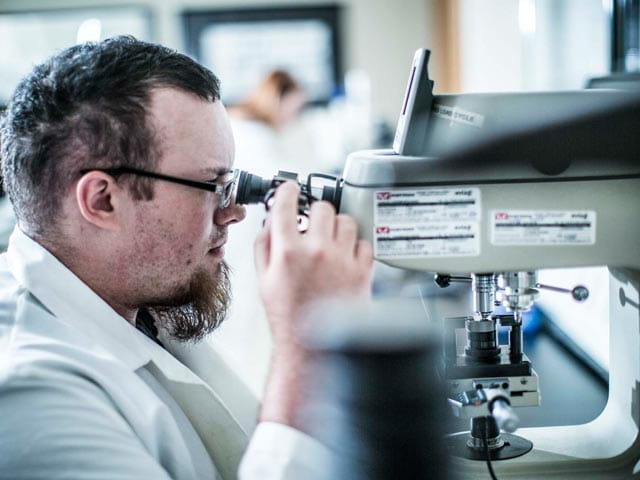Testing and Evaluating Thermal Spray Coatings

By Engaged Expert
Ryan CastellsRyan Castells is a highly experienced specialist in the material behavior of both PMC and CMC materials within the Aerospace sector.
What is thermal spraying?
Thermal spraying is a popular method of applying a metallic, ceramic, plastic, or composite coating to a device or material. The process finds uses across a wide range of industries, including medical, aerospace, manufacturing, and energy. Coatings are largely used to increase certain material properties in a device or component.
For example, a part that is going to be subjected to extreme heat may be coated with a certain formulation that will increase its thermal resistance. Thermally-sprayed, porous coatings are often used on medical implants because the porous surface encourages bone in-growth and fusion of the device. Coatings may also be applied to components in order to provide increased wear and corrosion resistance.
The coating material starts in a powder or wire form, and is heated to a molten state before being rapidly accelerated toward the object or material in the form of micrometer-sized particles. This acceleration is typically achieved using electrical arc discharge or combustion. As the coating particles begin to accumulate, the coating is formed.
Advantages of thermal spraying over other coating processes
- Allows for the application of thick coatings (up to 10+ mm)
- Larger application area and higher disposition rate than other processes
- Does not cause significant heating of the material surface, resulting is less surface degradation (also allows for coating flammable surfaces)
- Great flexibility in the type of material coating applied
- Combination coating with various materials is possible
- Does not require fusion to form a bond
Mechanical Testing of Thermal Spray Coatings
Mechanical testing on thermal spray coatings is a critical stage in the manufacturing and design process. Verifying the strength and wear resistance of coating formulations allows engineers to verify and develop processes to produce stronger and more effective coatings.
Typical Mechanical Coating Tests include:
- Pin-on-Disk Wear (ASTM G99) Pin-on-disk wear testing is an effective method of characterizing the coefficient of friction, frictional force, and rate of wear between two materials. During this tribological test, a stationary disk articulates against a rotating pin while under a constant applied load. This test is typically utilized as a comparison study between multiple coating formulations prior to final design and manufacturing.
- Tensile and Shear Testing (ASTM F1147, F1160, and F1044) Mechanical testing of coatings often require specimen preparation to create a testable sample. The coating is typically set and mounted to a metallic fixture using epoxy. The resulting test sample is then tested in tension per ASTM F1147 or shear per ASTM F1044 until failure. Shear fatigue is also often performed on coating test samples in accordance with ASTM F1160. Adhesion of the coating to the fixture is critically important for these strength tests.
- Taber abrasion (ASTM D4060) Taber abrasion is a cost effective, simple, and quick method of gathering comparable wear data for multiple coatings. The coating is subjected to cyclic abrasive force using specialized taber wheels. Pre- and post-test measurements are taken for generating mass-loss data.
- Coefficient of friction (ASTM D1894) Coefficient of friction testing consists of measuring both the static and dynamic frictional forces between two specified materials. Static resistance is the force that is required to initiate motion, while dynamic resistance is the frictional force required to maintain motion.
- Corrosion resistance (ASTM B117) The corrosive resistance of a coating can be measured using a salt spray environment. Per ASTM B117, the coating is subjected to an extreme corrosion environment for a period of time and evaluated for signs of a corrosive presence post-test.
Metallurgical Evaluation of Thermal Spray Coatings
Metallurgical evaluations are the most commonly performed tests for thermal sprayed coatings.
Commonly performed evaluations include:- Metallographic Evaluation A general metallographic evaluation of thermal spray coatings can generate a wide range of data, including: microstructure, thickness, roughness, porosity or void content, oxide inclusions, and unmelted particles, as well as the detection of cracks, delamination, interface contamination, and other coating flaws.
- Hardness Testing Hardness testing is also regularly performed on coating samples to obtain average hardness values as well as the hardness values through the thickness of the coating. Common coating hardness test methods are Rockwell, Superficial, Vickers, and Knoop.
Find related Resources
